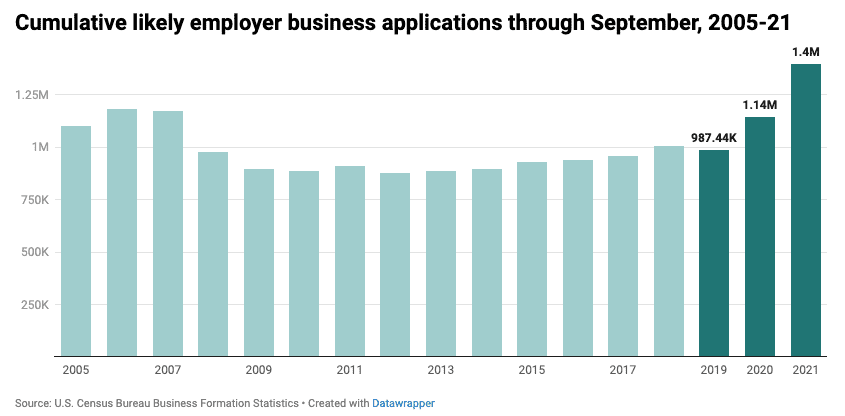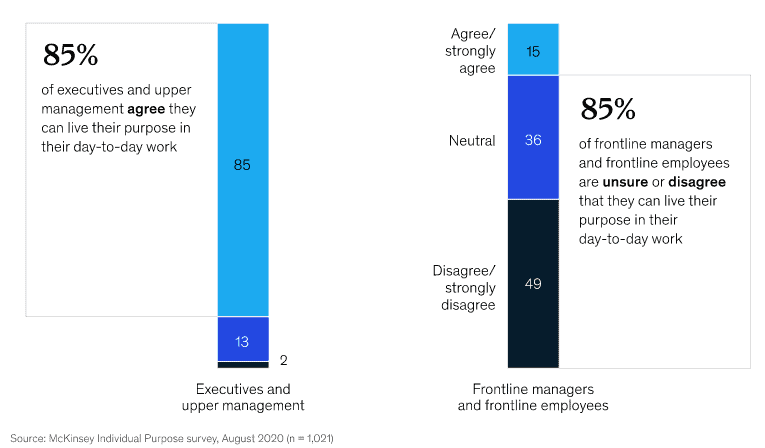10 Jan The Great Resignation or the Great Shift?

The term “Great Resignation” has made it into Wikipedia where it’s defined as “an economic trend in which employees voluntarily resign from their jobs en masse.” It was first coined by Anthony Klotz, an organizational psychologist at Texas A&M University.
What happened?
The Great Resignation began in early 2021, peaking in April and continuing at much higher levels than any other time in the last 20 years where voluntary separations have never exceeded 2.4% of the workforce. In July 2021, 4 million Americans quit their jobs, resulting in a peak of 10.9 million open jobs at the end of that month. Another 4.3 million quit in August, followed by 4.4 million more in September. Then there was Striketober, with a wave of strikes in October 2021.
The Harvard Business Review (HBR) published a piece in September about their study of exactly who has been driving this shift by analyzing more than 9 million employee records from more than 4,000 companies. They found that resignation rates were highest among mid-career employees between 30 and 45 years old with an average increase of more than 20% when comparing 2020 to 2021. Interestingly 20-25-year-olds and 60-70-year-olds had lower resignation rates than in the previous year. Could this be because mid-career employees are more likely to have young families? More on this later.
HBR also reported that resignations were highest in healthcare and tech (by 3.6% to 4.5%, respectively) which may be due to higher demands and burn-out in these fields. Meanwhile, resignations were lower in the manufacturing and finance fields.
Lastly, resignations have been higher for women than men. One in 3 women were considering downshifting their career or leaving the workforce entirely in 2021, McKinsey & Company and LeanIn.org’s report found. That’s worse than the 1 in 4 reported in 2020.
What does the latest data say?
According to the latest Bureau of Labor Statistics report available as of this writing, in November 2021 the number of monthly quits increased to a high of 4.5 million, while there were about 6.7 million hires, and job openings across the United States slightly decreased to 10.6 million in the same month.
Meanwhile, there has been a “startup surge” as indicated by business formation numbers in 2021at an all-time record of nearly 1.4 million applications filed to form new businesses through September of 2021, according to the Economic Innovation Group.

These numbers suggest that the Great Resignation is more of a Great Shift driven by employee choice, purpose, and personal situation. We will likely remain in an employee-driven labor market for some time. So every organization would be wise to consider employees’ and candidates’ needs and strive to create a Workplace Culture that is likely to attract and retain them.
Below is a summary of the 3 key factors – choice, purpose, and personal situation – and some ways to address each to help you improve your chances of attracting and retaining the talent that you need for your business to succeed.
Assess the Available Choices to Your Employees and Candidates
During lockdowns, many people discovered the joys of avoiding the rush hour, spending more time with their families, and having more control over their daily schedules. This is a shift that is not likely to be reversed any time soon. Fast Company surveyed 6,000 employees and found that flexibility is a top priority. Over three-quarters of respondents (78%) said they wanted to keep their flexible working arrangements and have the option to work remotely.
In this environment, organizations need to assess the choices that their current and potential new hires have in their industry. Insisting that everyone has to show up at the office when many in your industry have opted for a remote or hybrid work environment, will only result in losing your current employees and having trouble attracting talent. Also consider adjacent industries where employees can migrate to take advantage of these choices, as well as the profile and skills transferability of your employees. The more versatile they are, the more likely you are to experience challenges attracting and retaining talent.
Lastly, consider that many are opting to start their own businesses, as evidenced by the new business formation data provided above. While it’s difficult to compete with someone’s desire to start their own business, it is certainly a key factor to be aware of as it reduces the size of the talent pool available to you. The fact that industries like manufacturing are experiencing lower resignation rates supports this conclusion, as it is often challenging and there are more barriers to entry in starting a business in manufacturing.
Define and Communicate the Organization’s Purpose
According to McKinsey, “nearly two-thirds of US-based employees surveyed said that COVID-19 has caused them to reflect on their purpose in life. And nearly half said that they are reconsidering the kind of work they do because of the pandemic. Millennials were three times more likely than others to say that they were reevaluating work.”
Organizations have long overlooked this important factor in attracting and retaining talent. More than 70% of employees say that their purpose is defined by their work, and we know as a species, the purpose is important to us. So it’s a wonder that until now organizational purpose has not been defined and communicated more broadly. It’s been suggested that may be because of the gap between the leaders’ and employees’ perception about clarity of the organization’s purpose, as shown in the graphic.

Leaders need to clearly articulate the reason that the organization exists and how it contributes to a higher good. If you have a hard time defining your organizational purpose, try starting with the need that your business satisfies. Once you have defined the purpose, test the clarity of the wording and how it is perceived with your leadership and a few employees and adjust it as needed before sharing more broadly.
Address Various Personal Situations and Needs
Many organizational benefits and policies have been designed to meet the personal situations and needs of the majority of employees. In a tight labor market, like we are experiencing, organizations need to be proactive in understanding and addressing unique individual needs, especially of those employees and candidates from underrepresented communities. This may mean defining specific policies and benefits that meet the needs of employees who are parents, disabled, or lack access to technology and infrastructure in the communities where they live.
Leaders often complain about their lack of visibility to the unique needs of those employees that are under-represented. But all you have to do is ask. These days, there are many channels in real-life and in digital environments to invite input from employees and candidates. Consider a formal exit interview process to understand why your employees leave, and also with candidates who choose not to accept your offer.
We hope this piece has been helpful in providing you and your organization with information that can help you better understand and strategize on how to address the great resignation or the great shift. Please write us at ideas@ouroffice.io about your own thoughts and experiences on Hispanic Heritage Month.




